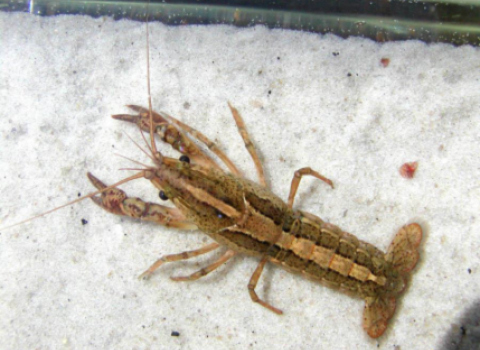DENVER -The endangered animals that call the Missouri River basin home are as iconic as the river itself, and a biological opinion issued yesterday by the U.S. Fish and Wildlife Service (Service) concludes that two shorebirds and one ancient fish found in the river and currently receiving Endangered Species Act (ESA) protections will not be jeopardized, even as in-river management activities move forward. In fact, the science-based adaptive management techniques proposed in the U.S. Army Corps of Engineers’ (Corps) Missouri River Recovery Management Plan will provide biologists with opportunities to deepen their knowledge of the piping plover, interior least tern, and pallid sturgeon in order to maximize conservation while also meeting the Corps’ obligations to other river interests.
The Missouri River is the longest river in America. It features a complex system of dams and reservoirs that are managed by the Corps to accomplish eight purposes as authorized by Congress, one of which is fish and wildlife conservation. The Service consulted with the Corps on their proposed plan to ensure that no ESA-listed species would be jeopardized, and that the Corps could continue to meet their authorized purposes.
Like any body of water, the river system can respond to natural and human-caused changes in a variety of ways. In order to best address the uncertainties within the plan related to current and future operations, and the species’ resulting response to those operations, the Corps worked closely with the Service, Tribes, states, federal agencies and other stakeholders to develop the adaptive management component of the Missouri River Recovery Management Plan. Informed by the best available science, this cyclical and responsive management approach allows the Corps to learn through doing: the Corps monitors and evaluates a species’ response to specific actions, then makes any necessary adjustments in order to achieve conservation while avoiding undue burden to other stakeholder interests.
“I’d like to extend my thanks to the U.S. Army Corps of Engineers, the Missouri River Recovery Implementation Committee, and Service staff who have worked collaboratively in the interest of wildlife and people to bring us to where we are today,” said Noreen Walsh, Regional Director for the Service’s Mountain-Prairie region. “Like the Missouri River, this plan is dynamic. It incorporates scientifically-sound management techniques that conserve the species while providing the Corps with the flexibility to adjust their activities as appropriate.”
For thousands of years, pallid sturgeon have lived, fed, and bred in the bottom of some of America’s largest rivers. A living relic from prehistoric times, pallid sturgeon can reach up to six feet in length, weigh up to 80 pounds, and can live to be 50 years old. Interior least terns are black and white shorebirds that nest on barren sandbars or beaches and feed in shallow pockets of water. They were nearly destroyed in the late 1800’s by people who prized their feathers for fashion. Since receiving ESA protections in 1985, interior least tern populations have seen substantial increases. Another shorebird, the piping plover, is sensitive to human disturbance and faces threats from loss of its nesting habitats. Today, with the assistance of habitat management actions, the piping plovers found in the Missouri River basin are experiencing high levels of productivity, and this contributes to the long-term health and recovery of the species as a whole.
Prior to its finalization, the final biological opinion underwent scientific review by the Missouri River Recovery Implementation Committee’s Independent Science Advisory Panel. The Panel found that the best available science was used, interpretations of the science were correct, no salient literature was overlooked, and that there were no fatal flaws in the Service’s analysis of impacts.
Conservation of imperiled wildlife in the Missouri River and across the country is made possible by the Endangered Species Act, the federal law that seeks to conserve species at risk of extinction. A portion of the ESA, Section 7 Section 7
Section 7 Consultation
The Endangered Species Act (ESA) directs all Federal agencies to work to conserve endangered and threatened species and to use their authorities to further the purposes of the Act. Section 7 of the Act, called "Interagency Cooperation," is the mechanism by which Federal agencies ensure the actions they take, including those they fund or authorize, do not jeopardize the existence of any listed species.
Learn more about Section 7 , requires all federal agencies working within the scope of their duties to help conserve and recover endangered and threatened species. To that end, the Service has worked in partnership with the Corps and other stakeholders in the Missouri River basin to meet the needs of both the people and wildlife that live there.
For more information on the Missouri River Recovery Program, visit www.moriverrecovery.org.
The mission of the U.S. Fish and Wildlife Service is working with others to conserve, protect, and enhance fish, wildlife, plants, and their habitats for the continuing benefit of the American people. We are both a leader and trusted partner in fish and wildlife conservation, known for our scientific excellence, stewardship of lands and natural resources, dedicated professionals, and commitment to public service.
Connect with our Facebook page at http://www.facebook.com/USFWSMountainPrairie, follow our tweets at http://twitter.com/USFWSMtnPrairie, watch our YouTube Channel at http://www.youtube.com/usfws and download photos from our Flickr page at http://www.flickr.com/photos/usfwsmtnprairie/.



